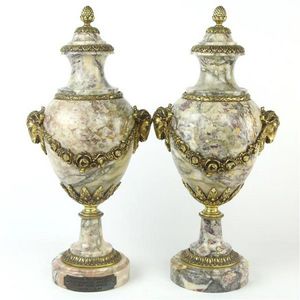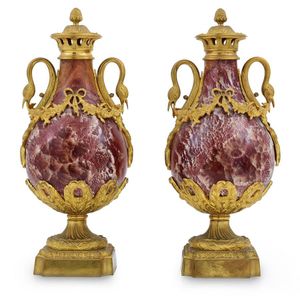Marble and Ormolu Cassolettes with Swan Handles
You must be a subscriber, and be logged in to view price and dealer details.
Subscribe Now to view actual auction price for this item
When you subscribe, you have the option of setting the currency in which to display prices to $Au, $US, $NZ or Stg.
- Ormolu - Ormolu was popular with French craftsmen in the 18th and 19th century for ornamental fittings for furniture, clocks and other decorative items. True ormolu is gilt bronze, that is bronze that has been coated with gold using a mercury amalgam. Due to the health risks associated with using mercury, this method of creating ormolu was discontinued in France in the 1830s. A substitute was developed consisting of about 75% copper and 25% zinc, however it was inferior to the bronze version. It was often lacquered to prevent it tarnishing.
- Cassolette - The origins of the cassolette date back to medieval times, where they were commonly used to serve stews and other hot dishes at banquets and other formal occasions. In the 18th century, cassolette dishes began to be made from porcelain and were often decorated with ornate designs, making them popular as decorative pieces as well as functional serving dishes.
During the 19th century, cassolette dishes became popular in French cuisine, where they were used to prepare and serve dishes such as cassolette de fruits de mer, a seafood stew, and cassolette de gibier, a game stew. - Floral Swag / Garland / Festoon - Floral swags are a decorative motif often used in the ornamentation of various objects, such as silverware, glassware, and furniture. The term "swag" refers to a garland or wreath of flowers, foliage, or other decorative elements, which is usually arranged in a loop or curve.
Floral swags can be found in a variety of decorative styles, from ornate Baroque and Rococo designs to more naturalistic Art Nouveau and Art Deco styles. They are often used to add a touch of elegance, refinement, or whimsy to an object, and can be seen on a range of items from chandeliers and candlesticks to picture frames and tea sets.
In the decoration of silver objects, floral swags are often used to accentuate the curves and lines of the piece, and to add visual interest to the surface. Similarly, on glass objects, floral swags may be used to frame or highlight a particular area of the object, or to add a touch of color and delicacy.
On furniture, floral swags can be found on a variety of pieces, from cabinets and armoires to chairs and sofas. They are often used to enhance the lines and curves of the furniture, and can be used to create a sense of movement and flow in the design.
Overall, floral swags are a versatile decorative element that can be adapted to a range of styles and applications, and have been used in the decoration of various objects throughout history. - Finial - An architectural decoration, found on the upper parts of of an object. On furniture they are usually found on pediments, canopies and shelf supports. On smaller ceramic or silver items, such as spoons, they may decorate the top of the item itself, or the lid or cover where they provide a useful handle for removal.
Finials have a variety of shapes and forms. They may be urn-shaped, baluster shaped round or spiral, but usually taper into an upper point. Many real life shapes may also be used as finials, such as pineapples, berries, pinecones, buds, lotus and acorns. Sometimes animals such as a lion are depicted, or fish and dolphins.
This item has been included into following indexes:
Visually similar items

A pair of Sevres pattern duck egg blue ground porcelain and gilt metal mounted covered vases approximately 80 cm high

A pair of fine Sevres pattern porcelain covered vases, French 19th century. 73.5 cm high

Two Royal Doulton cabinet vases, both baluster shaped, raised on circular spreading bases, both with cobalt grounds heavily gilded and each with two handles, one with a hand painted panel of summer flowers signed E. Wood. Tallest 17.5 cm

French marble & gilt bronze pair of urns having goat head handles, applied floral bunting, acorn finials & a plaque inscribed 'Hommage Reconnaissant Des Federations Apicoles À Me Verlinden 1890-1930'. Height 45 cm
